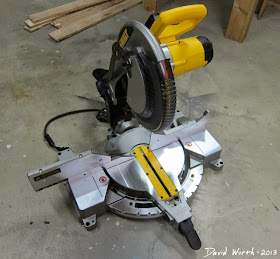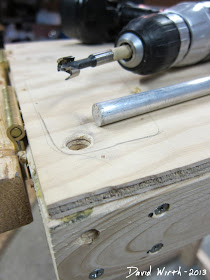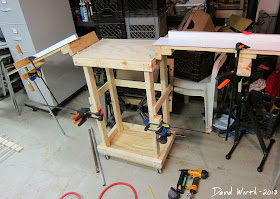A few weeks ago I wrote about the new miter saw that I bought. It was a real nice 12" DeWalt miter saw that I got from Lowe's on sale and with a 20% off coupon.
Until this point I just kept the miter saw on one of the workbench in my basement. The problem with keeping it on the workbench is first that it takes up a lot of space and second that it's difficult to cut longer boards. Anything over a few feet is difficult to support the board on the small miter saw and even harder to cut it when there's not a lot of space. My brother-in-law John has a real nice miter saw stand that he built using plans from the New Yankee workshop. That miter saw stand was one of Norm's all-time most popular projects on the show.
Unfortunately I didn't have that much space in my basement to build a stand that large. I needed something simple yet strong and something that would collapse down and take up just a small area. So I looked online and saw several good ideas but nothing that really fit with what I wanted to do. Also it needed to be on wheels so that I could roll it out of the way when I didn't need it. So after several different drawings and designs I finally had a rough idea and drew it on Google SketchUp.
Here's the Google SketchUp files in case you want to download them:
Here it is from another angle.
You can sort of see from the drawing that it wasn't a fully completed idea. I had the basic thought and shape of how was all going to work but not all of the finer details. I didn't know how the arms would be supported and also I didn't know how they would sit on the table to align with the miter saws back-plate. I made a lot of alterations while i was building it and figured that it would come together as i went along.
As with most of my jobs I used the cheapest wood I could find which was 2x3's and 1x3's. I cut them all to length using the actual miter saw that I was building stand for in the first place. The new miter saw is really great it makes real precise cuts and takes
much less time than the old hand powered one I used before.
I was connecting all the boards using drywall screws and glue. Here's the first marks i made to get the screws spaced evenly at the joint.
Instead of doing that for every corner I made a quick pattern on a piece of Tyvek. This was just a quick easy way to space out the screws which I would use to attach the boards, along with wood glue, so i didn't have to measure every time.
This is the basic 2x3 frame that I made. It was very simple yet strong. I calculated the overall height based on the fact that I would add wheels to the bottom of this, so about 3" higher.
Next I added 1x3's around the center and 1/4" plywood for the top. I stood it up and put the saw on to see how it would look. Not bad so far.
The next difficult step was an determining how to attach the collapsible arms. I knew they would swing out vertically and I figured that hinges would be the most stable solution. So I attached some old door hinges i had to each side. .
Then after measuring the height of the base-plate on the miter saw a determined that 2x4 would be a good start. The height of the fence was actually a little bit higher but I wanted to add white melamine on the top of the fence so that would would be able to easily slide back and forth. Here's the 2x4 that i screwed into the hinges.
To position the miter saw on the top of the stand there are four holes in the base of the saw. I traced out the outline of the saw and marked the position of the holes. I drilled the 4 holes into the plywood and 2x3's large enough to fit the aluminum rod i would be using.
Here is what those aluminum rods look like when they are set in place. This made for a solid positioning system and what is even better is that the bars are removable. If i had used screws or small diameter post then the saw would be able to move around, but by using the aluminum bars, which are the same diameter as the holes, the saw was almost locked into place and doesn't move at all.
Here's all 4 of the bars I used. After cutting them I used the rasp to round over the corners.
I was always planning to attach wheels to the base of the stand. These were the wheels I was originally planning on using because they were just the 4 that I had lying around. Although after testing them out I realized that they might not work. They were too small and the miter stand was a little too wobbly. Also they did not have any way to lock in place while i was cutting.
This is the start of building the folding arms. These two pieces would be the back rest to one of the sides. The 1x3 pine was for support and the melamine on the left would allow the board to slide easily.
Here's what it looked like when I was gluing both of them together. It took several clamps because I didn't use any nails or screws and i didn't want any gaps.
Next I started working on the second part of the arms, the horizontal base pieces. This process was basically the same as the backer pieces but I used larger boards and larger sections of melamine,
After everything had finished gluing I used my belt sander to remove any sharp corners and even the boards out. The heavy belt sander made quick work of making all the boards flush with each other.
This was a small section of 1x3 that I needed to glue into place for joining the arms to the 2x4 which attached to that hinges. It's served as a support and gave more of a surface area for gluing. It also helped to make sure the arms were horizontal to the fence.
This is what both of the hinged arms look like. You can see how the frames are made of wood and the surface is the white melamine, which reduces friction on the boards. Also you can see that I rounded the sharp outside corners of the boards.
This was a test run I did to see how the arms would hinge to their horizontal position. I was still trying to determine how I was going to make the arms work. I was debating between using a 2x4, a metal pipe, and a type of large hinge which would attach it either end.
I ended up using a 3/4" metal pipe. After drawing a lot of different sketches I figured that the metal pipe was the simplest answer and provide the most strength. The pipe would be supported by gluing two 1x3 blocks to the arms and stand. Then i would drill a 3/4" hole in the blocks for the pipe to slide into.
I don't have a picture showing the drilling process but it was actually quite difficult. I had to cut both of the metal pipes to the length I thought and then use them to determine the location of the 1x3 blocks. Then after gluing the blocks in place, I held up the pipe and drew a line for the angle at which the pipe intersected. I then took a 3/4" drill bit and drilled into the block at that angle. It took quite a bit of time before I got the depth and the angle right. Also it took even longer using curved wood rasp to open up a hole to allow the pipe to easily slide and lock into place.
After everything was attached in the glue had dried I used the drywall spackle to fill in any gaps. Also you can see from this picture that I attached two more small blocks
at the base where I would store the pipes when the miter stand was
folded up.
A quicksand and another coat of spackle and I was ready for paint. I filled in all the jagged edges and countersunk holes I made for the screws.
Here's what it looked like after the first coat of paint on the base stand. I decided to paint it red, for the same reason that i painted the welder cart red...it was what i had on hand.
Here's the wood welder cart that i made a couple months ago. I used 2 coats of red paint and 2 coats of polyurethane and it turned out looking ok.
Here's the base and arms during the painting process. I hung them from the ceiling as i painted so that i could get to every side.
Like i said earlier, i needed to find different wheels, and i ended up using these. They are larger, stronger, and had a locking lever. So it should be able to move easier and lock into place while i'm cutting.
And here is the final product with everything sanded, painted, and
polyurethane. Once again I decided to go with copper pipe because I
thought it looked really good and I had some left over pipes lying around the
basement. After testing it, the pipe at that angle is definitely stronger enough hold up any weight that I need to cut.
Another view with one arm folded in and one arm extended.
It actually turned out exactly how i was picturing it. I still might put the shop vac underneath and hook a flexible pipe up to collect the shavings. Or maybe i could just keep it even simpler and just use gravity to have the wood shavings drop through the pipe to a bucket.
I think it turned out great for its space saving ability, although it's not
super stable. Unfortunately with its narrow base, tall height,
combined with the wheels, and all the weight being up top, it wobbles a bit. It will definitely work
for what I'm using it for, but if you ever wanted to remake this yourself
I would recommend somehow extending the wheelbase. Although that kind
of defeats the purpose of having a compact miter saw stand. Maybe i can put a heavy piece of steel in the base to keep it steady.
But overall I'm quite happy with how it turned out. Now when i have to use it for a project i just have to wheel it out, fold out the arms and cut any board. Then when i'm done with it, fold it up and tuck it back into the corner.



































No comments:
Post a Comment